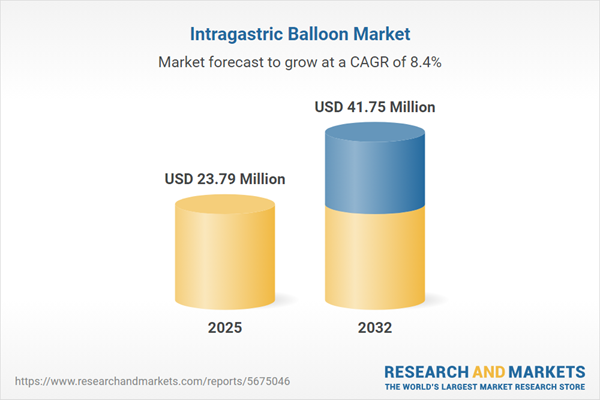Speak directly to the analyst to clarify any post sales queries you may have.
The intragastric balloon market is evolving rapidly as healthcare providers seek innovative and compliant solutions for weight management. Senior decision-makers must navigate a landscape defined by clinical advancement, integrated operations, and shifting regulatory demands—requiring strategies that balance risk, cost efficiency, and patient outcomes.
Market Snapshot: Intragastric Balloon Market Size and Growth
In 2024, the global intragastric balloon market reached USD 21.95 million, with the market expected to grow to USD 41.75 million by 2032 at a compound annual growth rate (CAGR) of 8.36%. Key factors fueling expansion include increasing obesity rates, amplified acceptance of non-surgical weight management, and a greater emphasis on validated, evidence-based medical devices. The sector reflects dynamic device customization, evolving reimbursement frameworks, and closer partnerships between health technology providers and care organizations. These shifts are strengthening device adoption in established healthcare settings and enabling wider reach into developing regional markets. The sector’s alignment with value-based care and broader obesity management programs underscores the strategic importance for healthcare leaders.
Scope & Segmentation: Intragastric Balloon Device Market
- Device Types: Endoscopic intragastric balloons, which include gas-filled and liquid-filled options, support tailored interventions for diverse patient needs. Non-endoscopic devices improve access and offer flexibility, complementing existing obesity management strategies.
- End Users: Bariatric centers, specialist clinics, and general hospitals are the primary users, facilitating both inpatient and outpatient programs that drive cohesive healthcare planning and patient engagement.
- Distribution Channels: Hospital and retail pharmacy chains ensure streamlined device supply, supporting reliable access for routine procedures and acute interventions alike.
- Applications: Intragastric balloons serve as a tool for pre-surgical weight loss and form part of sustained strategies for long-term obesity prevention, assisting organizations in developing personal and population-level care protocols.
- Regions Covered: The market is global, spanning the Americas, Europe, Middle East, Africa, and Asia-Pacific, with local conditions shaped by healthcare infrastructure, reimbursement policies, and regulatory processes. Distinct regulatory and adoption challenges are present in the United States, Brazil, Germany, India, Canada, and China.
- Key Companies Profiled: Market advancement is led by Apollo Endosurgery, Allurion Technologies, Obalon Therapeutics, ReShape Lifesciences, Spatz Medical, MedSil, Silimed, ENDALIS, GI Dynamics, and BARIATRX, entities recognized for continuous technology investment and collaborative regulatory engagement.
Key Takeaways: Strategic Insights for Decision-Makers
- Digital patient monitoring and engagement technologies are enhancing adherence and empowering clinical teams to deliver precisely tailored care protocols.
- Refinements in reimbursement mechanisms improve device access and budgeting, supporting more predictable and streamlined technology adoption for providers and payers.
- Device diversification enables organizations to match product features with varying clinical workflows, facilitating more cohesive care collaboration across settings.
- Joint strategies among device manufacturers, healthcare providers, and technology partners are accelerating approved device integration into clinical pathways, advancing both early intervention and robust outcome monitoring.
- Consolidated sourcing and procurement initiatives assist organizations in responding proactively to regulatory adjustments and maintaining stability in device supply under evolving market conditions.
Tariff Impact: Regulatory Shifts and Supply Chain Strategy in the US
Recent US tariff changes are compelling healthcare organizations to strengthen their focus on domestic and nearshore manufacture of intragastric balloon devices. This trend favors adoption of bundled purchasing and shared-risk procurement models, with the goal of improving supply chain control and cost management as clinical requirements evolve and regulatory standards shift.
Methodology & Data Sources
This market evaluation draws on insights from over 100 interviews with industry experts across clinical, commercial, and payer sectors. Findings are rigorously cross-referenced with regulatory data, clinical study results, tariff analyses, and supply chain reviews, with senior executive input confirming sector relevance.
Why This Report Matters
- Provides senior decision-makers with a structured roadmap for integrating intragastric balloon solutions into diverse procurement and care delivery environments.
- Clarifies practical solutions for navigating changing regulatory landscapes and optimizing regional supply chain strategies to support evolving obesity treatment models.
- Delivers actionable segmentation and digital health insights, supporting the adoption of coordinated, evidence-driven obesity care at scale.
Conclusion
Intragastric balloon devices play a vital role in modern obesity management. This report offers healthcare leaders the strategic clarity needed as technology and compliance requirements continue to evolve.
Additional Product Information:
- Purchase of this report includes 1 year online access with quarterly updates.
- This report can be updated on request. Please contact our Customer Experience team using the Ask a Question widget on our website.
Table of Contents
3. Executive Summary
4. Market Overview
7. Cumulative Impact of Artificial Intelligence 2025
Companies Mentioned
The companies profiled in this Intragastric Balloon market report include:- Apollo Endosurgery, Inc.
- Allurion Technologies, Inc.
- Obalon Therapeutics, Inc.
- ReShape Lifesciences, Inc.
- Spatz Medical, Inc.
- MedSil, UAB
- Silimed, S.A.
- ENDALIS GmbH
- GI Dynamics, Inc.
- BARIATRX Ltd.
Table Information
| Report Attribute | Details |
|---|---|
| No. of Pages | 194 |
| Published | November 2025 |
| Forecast Period | 2025 - 2032 |
| Estimated Market Value ( USD | $ 23.79 Million |
| Forecasted Market Value ( USD | $ 41.75 Million |
| Compound Annual Growth Rate | 8.3% |
| Regions Covered | Global |
| No. of Companies Mentioned | 11 |









